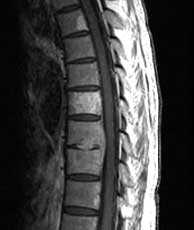 |  |  |
| T1 pre-gad | T1 post-gad | T2 |
Diagnosis: Staphylococcal disc space infection
S.Aureus causes 1/2 of discitis cases. Other etiologies of disc space infection and osteomyelitis include TB, and brucellosis. In adults, the organism invades the subchondral bone by hematogenous spread and enters the disc space. In children it usually begins in the disc space because in the pediatric population the disc space has a vascular supply. Disc space narrowing is the earliest sign of discitis due to herniation of the nucleus pulposis into the vertebral body through the end plate which has been weakened by the infection. Patients may present with systemic symptoms and low back pain. The most common locations for discitis are L3-4 and L4-5 and is unusual above the T9 level. Findings may include a narrowed disc space, a paravertebral soft tissue mass with epidural extension or collapse of the adjacent vertebral bodies. In advanced cases it may be difficult to differentiate discitis from malignancy. If it is clear that the mass has originated in the disc space, metastases or lymphoma are unlikely since they tend to involve the vertebral bodies sparing the disc space. Related Cases








